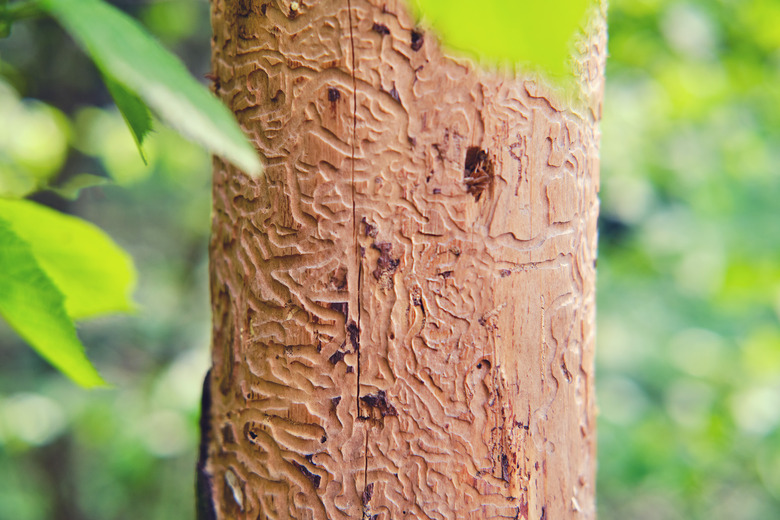How To Kill Pine Beetles In Your Trees
We may receive a commission on purchases made from links.
Do you think you need to kill pine beetles in your trees? Pine beetles are a species of bark beetle and live in pine trees (Pinus spp.). They can be rusty-brown or black and are only about 1/4 inch long, about the size of a pencil point. Even though they are small, they work in large numbers and can destroy trees, so it's important to know how to deal with an infestation.
Pine Beetles Devastate Pine Trees
Pine Beetles Devastate Pine Trees
Adult pine beetles dig tunnels under tree bark, leaving their larvae behind. These larvae interrupt the flow of food that is produced by the tree's needles so the nutrients cannot make their way down to the roots. The beetles also transmit a blue stain fungus that prevents food and water from moving throughout the tree.
Thousands of acres of forests in the United States have been decimated by pine beetles, and this devastation has led to pine trees dying and animals not having enough to eat due to the disruption of the ecosystem. These beetles also cause damage to trees in parks, in open spaces and on residential properties.
Signs of Pine Beetles
Signs of Pine Beetles
There are different types of pine beetles, and pine trees may show a variety of symptoms that indicate their presence. Mountain pine beetles leave boring dust in the crevices of the bark and on the ground right next to the tree's base. The tree's pine needles may also turn yellowish-red and then rust-colored before they drop off.
Another telltale sign of infestation is "pitch tubes," which can be seen on the trunk. This is where pine beetles tunnel. The tubes can be white, pink or brown. There may also be exit holes on the bark or signs of woodpecker damage. These birds feed on pine beetle larvae.
Can Beetles Be Killed?
Can Beetles Be Killed?
Once a tree has been attacked by pine beetles, it is too late to save it. Instead, experts recommend preventative measures that will kill the pine beetles before infestation. Certain insecticides that are labeled for bark beetle control can be used up to the beginning of June each year. These products have ingredients like permethrin, carbaryl and bifenthrin and are made by familiar brands like Sevin and Spectracide. It is important to look for the words "bark beetle control" on the label.
Toxic pesticide chemicals can be inhaled, ingested and absorbed by the eyes and skin, so before applying any pesticide, certain safety precautions must be taken. Read the label thoroughly and wear safety goggles and other personal protective equipment, like work gloves and a shirt or coat with long sleeves.
If the pesticide needs to be mixed, do it outside using only the amount specified. Doubling the ingredients can be harmful, and it cannot be stored once it is mixed. Also, be sure to never eat, drink or smoke while working with pesticides.
Applying Pine Beetle Pesticide
Applying Pine Beetle Pesticide
Treat your pine tree by thoroughly wetting the bark with the pesticide; it should be almost to the point of runoff. It has to be applied all the way around the trunk, starting at the base and up to where it tapers to about 3 or 4 inches in diameter.
Use a sprayer with enough pressure to reach the upper part of the trunk. For trees less than 25 feet, use a 250 PSI sprayer, and for taller trees, a higher PSI sprayer is best.
